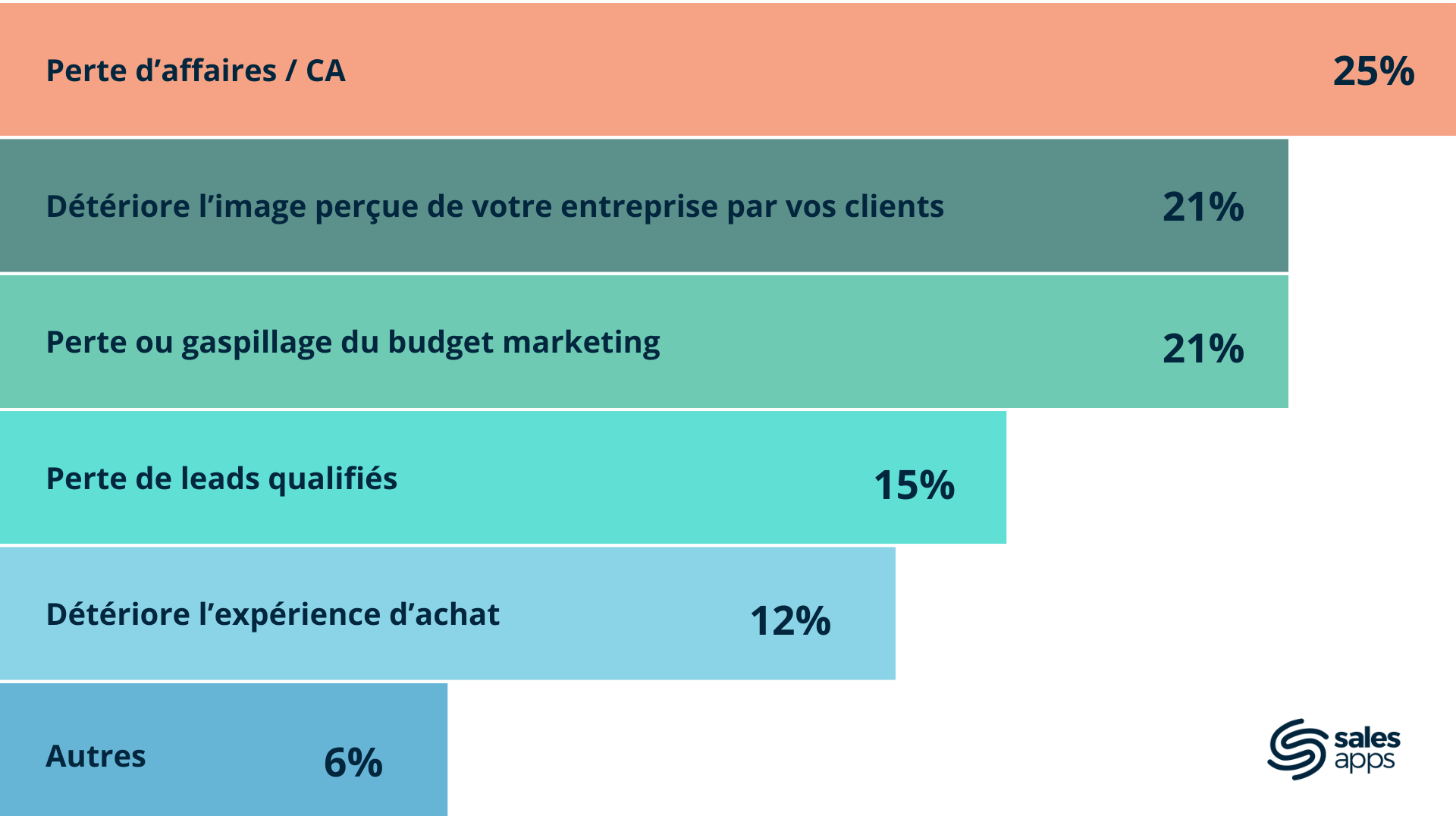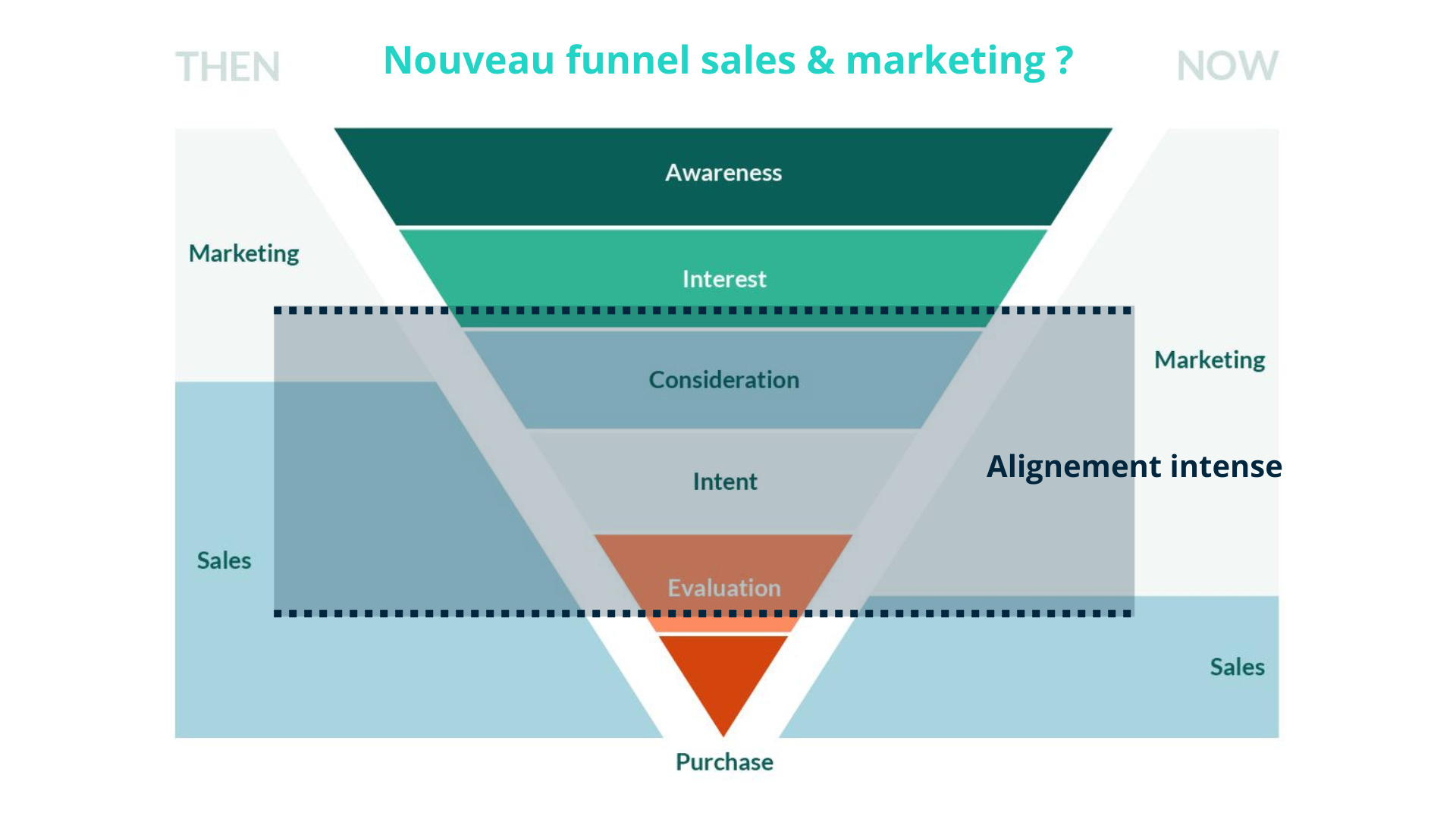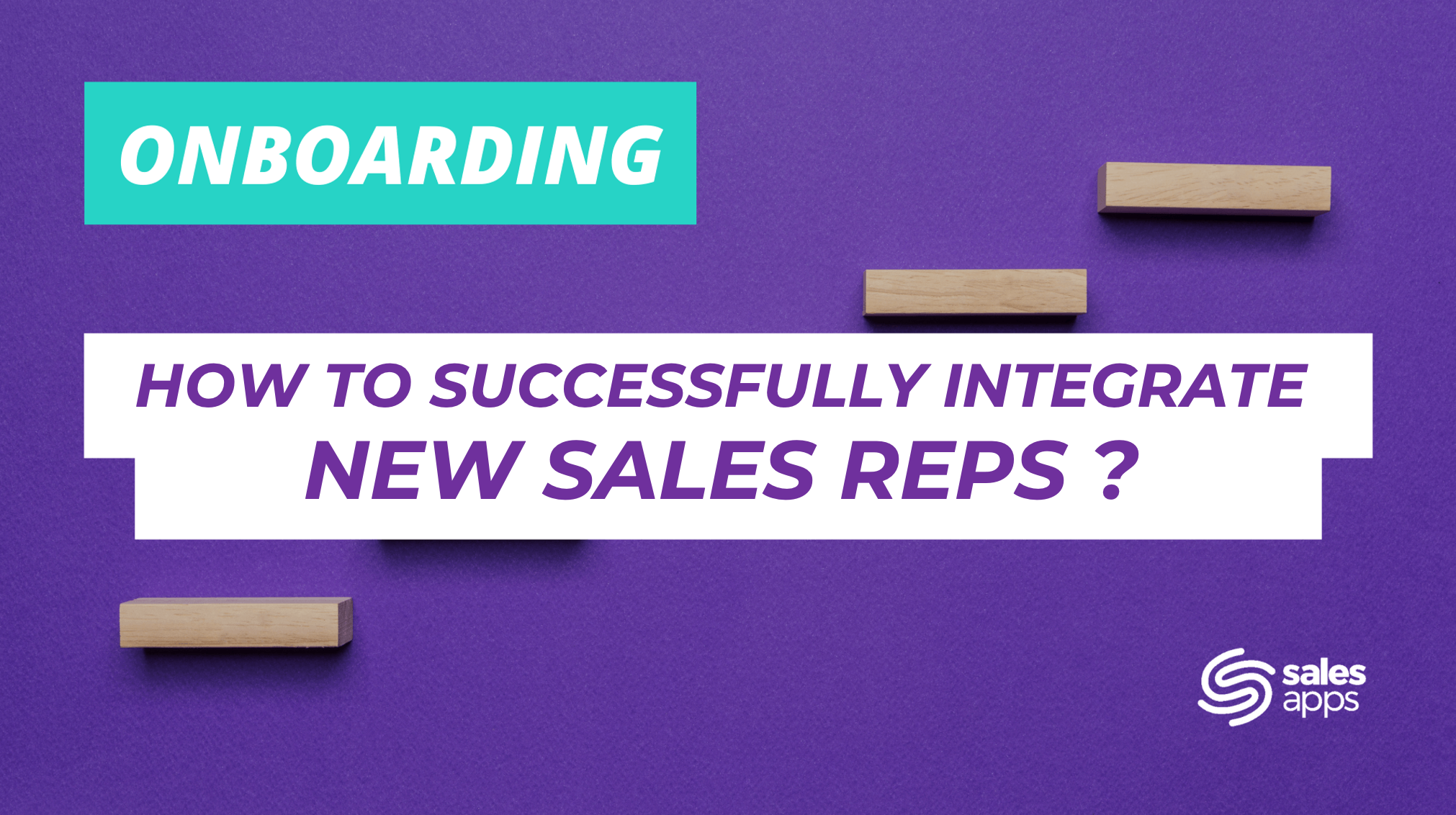
Blog

Boost your sales pitch by aligning your sales & marketing teams!
In 2023, Gartner published a study on the evolution of B2B purchasing processes, highlighting the inexorable reduction in the time buyers spend meeting with sales reps.
On average, only 17% of the salesperson's time is spent on buying tasks, and even 5% when drawing up a shortlist; 57% of the buying process is even consumed before the first meeting with a salesperson. This naturally has an impact on the appointment itself, and puts the salesperson's professionalism to the test.
The salesperson's ability to embody the marketing message during the appointment, and to give depth to the content, is a key issue for the Marketing x Sales organization. Marketing content, team training, soft-skills, etc. all need to be carefully adjusted to improve the quality of the sales pitch during appointments.
What is a sales pitch?

Technically speaking, the salespitch is what the sales reps use to sell a product/service to a b2b buyer. In practice, the sales pitch has become polymorphous, addressing a growing variety of themes(CSR, RGPD, Techniques, etc.).
For salespeople to be able to perform in a wide range of situations, they need to be seen as successful, like sportsmen and women: adapted, dynamic and practical. Marketing plays a key coaching role in achieving this objective. The success of the sales pitch in appointments therefore depends largely on the ability of the sales & marketing teams to align.
The importance of aligning sales & marketing teams?

Although their missions are supposed to converge towards the same objective of growth for the company, in practice, sales and marketing teams still interact little on a day-to-day basis. This is underlined by CMIT's 2022 study: "57% of companies feel that their marketing and sales reps are not aligned".
Although the trend is downward, the situation remains a reality for many companies. Good alignment of sales and marketing can help a company "improve its ability to close deals by 67%" (Learn Hub), so the subject is a priority.
Improved alignment actually impacts many other components: the ability to adapt marketing content to the needs of appointments, field feedback, head office/field communication, the marketing message as seen by the customer, and so on. Conversely, poor alignment has a negative impact on many aspects of sales performance.

How can marketing help improve your sales pitch?

Considering the Sales & Marketing funnel and the supposed areas of responsibility between Marketing and Sales, we might be tempted to basically apply the reduction in time allocated to meeting sales reps (more than 17% according to Gartner) by making Marketing responsible for phases formerly handled by Sales.
In reality, this is not true; on the contrary, the salesperson is perfectly heard & expected by buyers in these core funnel phases, with a particularly intense need for alignment with marketing. It is precisely during these phases that salespeople have a key role to play in their ability to embody the marketing message, giving it body and soul.

How can marketing impact appointments? How can marketing improve the sales pitch?
1 - Streamline access to content and information
A single communication channel is essential to facilitate content sharing with the sales force. This sharing of information must take place in real time, guaranteeing sales staff access to the latest version.
This information must also be available regardless of the situation in which the sales rep finds himself, whether he's in a meeting with or without a network, in the preparation phase, on the road, etc.
The content access format must be designed with the salesperson in mind, favoring access based on appointments, usage and customer needs, rather than a simple, ergonomically poor catalog.
The importance of adapting the organization of content to the needs of sales reps is decisive, not only to simplify their daily activities, but also to help them use all the content at their disposal.
By analyzing how content is actually used by teams, and by involving sales reps (via a bottom-up channel), we can engage marketing and sales in an active, iterative alignment that is particularly effective.
2 - Designing content to sell
"According to Smart insight, "91% of B2B companies invest in marketing content, but only 35% measure the interest and actual use made of it. Quite often, the content made available is in an all-in-one format, such as a presentation of over 50 slides, combining a volume of information with a rigidity of use...
Content for sale is designed for the use that will be made of it in meetings, and is conceived with the principle of content for a specific purpose in mind: presenting 1 offer, presenting your company, presenting your CSR charter, presenting 1 customer reference, etc.
The aim of this breakdown is to simplify the use that could be made of it, and to give the salesperson agility during the appointment or in preparation for it. Obviously, this content needs to be graphically engaging and up to date to support the sales pitch. To sell, this unitary content needs to be orchestrated using an interface that contextualizes the salesperson's words and visually enhances his or her sales pitch.
This is how storytelling & the personalization of the sales meeting become possible. It is in this storytelling approach that the Marketing x Sales contribution is most fruitful.
The best practice is to have your best sales reps contribute to the development of the best sales paths they use, and then enrich these paths with complementary content. The impact of their sales pitch will be greatly enhanced, enabling them to better demonstrate the added value of their product and effectively engage their interlocutor.
3 - Training and building the confidence of sales reps
The sales pitch is the fruit of a joint effort by sales experts, top sales performers and marketing specialists. For the sales pitch to really bear fruit, it must be embodied by the entire sales team: top sales reps, experienced sales reps, newcomers, etc.
The more the sales force masters the paths, content and uses, the better they will present them during meetings, and the more they will be understood by customers. Putting them into practice/situations is a must.
In addition, a good training strategy and coaching will enable the sales rep to naturally gain in confidence and thus develop his added value from the buyer's point of view. The value of the salesperson's involvement in meetings will clearly be to give meaning to the information and to show greater professionalism towards the customer.
4 - Communicate, share, energize
The marketing team plays a crucial role in sharing best practices with sales reps. More than simply disseminating the information for which it is responsible, Marketing must provide the sales team with the logic behind its design and the means to apply it in appointments or in preparation.
In the case of a breakdown of information through storytelling pathways, part of the usage is induced by the time at which the content is available, but it may happen that some content integrates partially common information, so it is advisable to specify the unique meaning of the content for the commercial approach.
Media coverage of new content must be differentiated according to the importance of the novelty. Clearly, a marginal correction to a product sheet cannot be given the same prominence as a commercially aggressive promotional offer of limited duration. The same applies to the animation of content distributed to sales reps.
Your distribution must take into account the importance of the information and your expectations as to how it will be taken into account by the teams. The rule of thumb for effective communication is to avoid saturating the distribution channel with "critical" information, "to be taken into account on the spot".
By offering sales reps simple ways of passing on information or suggestions, marketing gains the opportunity to demonstrate its ability to listen and lead. The media coverage of good practices spontaneously suggested by the field naturally encourages greater acceptance of top-down information as a whole.
The sales pitch: what's at stake for marketing and sales managers?

Aware of the transformation of the appointment format and the new challenges of Modern Selling, McKinsey published a study in 2023 detailing the 4 components of B2B sales performance:
1 - The reign of agility
Agility is as much about the organizational flexibility and adaptability of a sales team as it is about the agility of the salesperson to adapt his or her appointment schedule, as described above. Agility is a key factor in sales performance, since it can increase sales by 5% to 10% (McKinsey).
An agile organization facilitates the salesperson's activity and adaptability during the various phases of the appointment: the need for simple access to thematic content to enhance the sales pitch, the need to present in a location without an Internet connection, rapid knowledge assessment during the appointment preparation phase, or even the production of a visit report with a 100% guarantee of the usability of the data behind it by the marketing team.
At the heart of this reality is the need for information that is constantly up to date, easily accessible and available when you need it.
2 - Ready-to-use ideas
Ready-made ideas refer to elements that place the salesperson in the position of conductor. He or she must always be one step ahead, or at least have a slight advantage, enabling him or her to steer the meeting in the desired direction.
These ready-to-use ideas are materialized in the form of content or training, and should prevent the sales person from finding themselves in situations that result in phrases such as: "I don't know", "I don't have any content on the subject", "I'll find out and get back to you", or simply a blank in the middle of the sales pitch.
He must therefore have at hand a set of marketing contents for his exchange with the buyer (accessible in less than 3 clicks). The sales rep must also be able to respond to the buyer's questions by contextualizing his answers with new content, and be able to provide more targeted content depending on the progress of the appointment and the buyer.
3 - Technology unleashed
Liberated technology refers to the use of technology to the benefit of salespeople, enabling them to devote most of their time to what really counts: selling! Today, they spend 67% of their time on activities with little added value for their company (LinkedIn), such as content research, content personalization, or feeding the CRM.
In the case of marketing content, its creation must be handled by the marketing department, and its accessibility must not depend on sales, as is sometimes the case when it is stored on Drives or SharePoint.
Technology and the tools available to it must truly act as facilitators of the salesperson's work. As we mentioned before, this is also a crucial issue for management. 77% of companies consider CRM data to be of poor or very poor quality (McKinsey). And yet, sales reps spend an average of 11 hours a week entering data into CRM (Gartner). Given the FTE budget allocated to CRM, one might expect exceptional data.
Once again, technology has a key role to play in automating the majority of reporting (90%). At the same time, automation improves the quality of the data collected, making it easier for marketing to exploit.
Technology plays a role for marketing in disseminating information and analyzing usage statistics. The media created, for their part, must be easy and quick to distribute to the sales force, and protect them from numerous instances of content personalization, content not found, content in another language, and so on.
The marketing team also needs KPIs to assess performance and arbitrate investments. By tracing all the events (sales paths, content presented, sales pitch used...) that took place during the appointment, the company has a gold mine for understanding the environment in which it is evolving, and can continually improve its marketing messages.
4 - Activating skills
Reveal talents and develop sales skills for everyone, right from the Onboarding stage. New recruits need time to assimilate the company's sales pitch and be able to apply it effectively in meetings. The challenge for a marketing department is to ensure that sales staff are up and running as quickly as possible (mastery of offers/services, sales pitch...) in order to sell.
To do this, it must ensure that the formative content is accessible and that the sales force is exposed to it regularly, i.e. as often as necessary. The salesperson's confidence is also a key factor in the success of the meeting. Rather than reciting a script by heart, the salesperson must be sufficiently knowledgeable to appropriate the sales pitch and adapt it naturally to each situation.
Sales Enablement to monitor and improve the quality of sales pitches during meetings

Sales Enablement, the cornerstone of yoursales and marketing alignment strategy, guarantees the quality of the messages conveyed to your buyers via sales reps.
1 - Storytelling to give impact to your sales pitch
Getting a prospect to buy into your sales pitch isn't easy. Traditionally, it's the salesperson's talent and eloquence that make it possible to create strong support for the sales pitch. This adherence allows key information to be disseminated, giving the prospect the best of what the company has to offer.
This buy-in is the first step in the sales process - the "seduction" step, the one that makes people want to buy. Structuring your marketing content approach through storytelling paths enables you to share with all sales reps the experience of the best salespeople who have designed these paths.
These storytelling paths can be of different kinds, depending on the company's activity, and oriented: by customer type, by need, by length of appointment (short or long), etc. This specialization in the use of content, as opposed to the generic 400-page catalog or 70-slide presentation, helps to create adherence from the outset, and significantly increases the use of marketing content of all types (presentations, of course, but also references, videos, images, testimonials, etc.).
2 - A sales environment that makes salespeople agile when dealing with buyers
The salesperson's environment plays a role in the success of the customer meeting. By putting marketing content at his disposal in sales paths, the salesperson is more relevant in his approach to the buyer. Not only will he be able to personalize his presentation, he will also be able to contextualize it with the right arguments.
The Sales Enablement application has been designed to adapt to the progress of the meeting, enabling the salesperson to react in real time to the exchanges. Links between content enable the sales pitch to be tailored to the buyer's questions and objections.
The 100% appointment-dedicated interface integrates only appointment content, enabling you to share 100% of the display with your customer, and to adopt a side-by-side rather than face-to-face position.
As a result, sales reps are better equipped to deal with unforeseen events, adopting a natural approach and greater agility in their sales pitch. This allows them to be flexible in what they say, and to bring in new content without weighing down the meeting.
3 - Quizzes to improve your knowledge of sales reps
With regard to sales reps training, Sales Enablement and its analysis of the use of content for training purposes enables better customization of training programs.
The Quiz format enables the marketing department to constantly evaluate mastery of offers/services across all sales reps. The effectiveness of training is greatly enhanced, as sales reps can test their knowledge at any time of the day, whether before a customer meeting, on the move on their mobile or in the office on their computer.
The gamification mechanisms built into the application help to engage users. In this way, you can highlight certain quizzes and stimulate their use. By making your sales training programs accessible and integrating a gamified experience, you can accelerate the skills development of new recruits and reinforce knowledge development across the entire sales force.
You'll be helping to improve your knowledge of products/services, sales techniques and the sales pitch that will help you hit the bull's-eye in appointments.
4 - The Training format to sharpen the sales pitch in meetings
In addition to the Quiz format, a Sales Enablement tool offers marketing & sales managers a complete program to help salespeople fully master their sales pitch during sales presentations.
In this way, the sales force can learn at their own pace the right sales arguments and pitches to suit the content presented to the buyer.
This format takes the form of intuitive pop-ups, and is highly effective in boosting salespeople's confidence in their ability to communicate intelligently about their company's products/services. The result? A consistent, controlled and powerful message that sells more and better in appointments.
5 - A powerful back office to control and distribute your marketing messages
The strength of this tool lies in its ability to provide marketing & sales managers with a powerful back-office where they can quickly publish their marketing content and distribute it instantly to their sales force.
Publishing rights ensure that marketing messages are used effectively in appointments and sales pitches. Add to this KPIs and the fact that the tool connects with the CRM (Hubspot, Dynamics, Salesforce, Zoho, Sugar...), and you have a wealth of real-time information on what is presented or said during the appointment.
Sales reps can take notes if necessary, without leaving their app and disrupting their meeting with the buyer. In this way, managers can improve their sales & marketing strategy with relevant data directly from the field, enabling them to fine-tune the sales pitch of their sales reps.
6 - Features to foster sales team collaboration
Your Sales Enablement platform can also integrate other collaborative features to facilitate exchanges between sales reps .
For example, when it comes to field feedback, many companies use traditional instant messaging applications, which have the huge disadvantage of the information's lifespan on these platforms. Imagine, for example, that 40 sales reps share a best practice photo every week, and after a month there are 160 photos in an unorganized stream.
Finding or using even the smallest asset is virtually impossible. On the other hand, in a Sales Enablement tool, these photos can be tagged when they are sent, making them easier to identify over time and reinforcing team commitment.
Rather than being seen as a constraint or an additional daily task, field feedback becomes an activity in which sales reps find real added value. Thanks to the gamification system integrated into the application, sales reps can earn badges or points according to the number of photos shared, the number of likes received on a photo, as well as the quality of their field reports. The aim of this feature is to improve the quality of field feedback, while at the same time stimulating sales reps through incentives managed by management.
With its Instagram-like feed, the sales force can access content shared by each salesperson, while certain content is reserved for central teams. The results? The salesperson's work is enhanced, thesales & marketingorganization is strengthened and has a continuous source of information from the field.
Join Salesapps ENGAGE, to be informed of our upcoming events.
FAQ
What is a sales pitch?
A sales pitch is the sum of a sales argument and a pitch whose aim is to convince a prospect to buy a product/service.
How do you build a sales pitch?
A well-rehearsed, structured and standardized sales pitch to the sales force boosts your company's commercial performance. Here are the different stages: identify and understand your target's needs, prepare the questions to guide your sales pitch, define the key messages to promote the product/service, structure the sales pitch and personalize it according to the interlocutor, and prepare responses to objections.
How do you control a sales pitch?
The word "control" is the most appropriate, and it's possible when you're part of a marketing department to get a grip on what's being broadcast and said at customer meetings. Effective training of sales reps, using the Quiz format, guarantees a good understanding of offers and services, while training sessions guide sales reps towards the proper use of sales pitches during their presentations.
What are the most common sales pitch mistakes?
Making a monologue, failing to prepare for the buyer's objections, limiting yourself to technical arguments and failing to contextualize what you're saying are among the most common mistakes.



